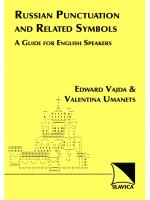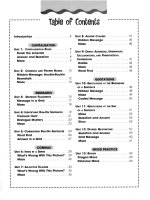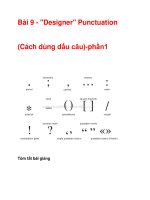UEfAP punctuation
Bạn đang xem bản rút gọn của tài liệu. Xem và tải ngay bản đầy đủ của tài liệu tại đây (355.19 KB, 10 trang )
UEfAP Punctuation
The sentence and the full stop
The full stop is the most important punctuation mark. It shows the end of the sentence. The
English language also uses capital letters at the beginning of sentences.
For example:
The first schools in what is now British Columbia were established by the Hudson's Bay
Company in about 1853 on Vancouver Island. The present public school system originated
with the Public School Act of 1872. Education is free and compulsory for children ages 7 to 15.
Schools are funded by the provincial government and local property taxes. The province's 75
school districts are administered by locally elected boards.
Exercise
Try this exercise: Exercise 1
The comma
The comma is the most important punctuation mark after the full stop. Its main use is for
separating parts of sentences. Commas function in five main ways:
1. Before or after adverbial clauses and groups.
2. Before various connectives to join two independent clauses.
3. To separate some nondefining phrases from the rest of the sentence.
4. To separate words, groups and clauses in a series.
5. To separate adjectives that separately modify the same noun.
1. Before or after adverbial clauses and phrases
For example:
Recently, the number of service enterprises in wealthier freemarket economies has grown
rapidly.
Subsequently, the aircraft underwent numerous design changes before it was incorporated
into the Type 4 jet aircraft.
To visit his brother, he drove through the night.
After dinner, he walked around the town.
/>
1/10
Although it might seem highly unlikely, there are considerable similarities between the male
and female body.
Similar feelings influenced middleclass shareholders and directors, too.
When the activity of our kidneys is considered, a bedtime drink does not waken us by filling
our bladders during the night.
Some businesses only seek to earn enough to cover their operating costs, however.
Because stocks are generally negotiable, stockholders have the right to assign or transfer their
shares to another individual.
After the war, the United States Army occupied Japan and ordered the dismantling of
Mitsubishi and other Japanese conglomerates.
If we work at night and sleep during the daytime, we have difficulty in adjusting our habits.
The patient's perception of his environment and his response to it is likely to be grossly
reduced, since he might be unconscious or paralysed, for example.
It is very useful to use a comma to separate these intitial clause or phrases as it helps
copmprehension.
2. Before various connectives to join two independent clauses
(and, but, or, so, nor, for, yet)
For example:
What we require is a National Emergency Government, but no two men I meet can agree how
this can be formed.
The house badly needed painting, and the roof needed repairing.
Lord Knollys was not particularly pleased with these proposals, nor were other members of the
Cabinet.
A loose stretch would wrinkle too easily with successive washes, or might even wrinkle on a
damp day.
There was no Canadian Consulate in Paris at that time, so we had to go to the American
Consulate for ours.
It was clearly not an allparty government, yet it was something more than a mere
Conservative front.
These experiments led to theories about how development was controlled in terms of cell and
/>
2/10
tissue properties, but it was very difficult to link these theories with gene action.
The condition of the Liberals was far more serious than that of Labour, for the Liberal party
was beginning to lose its sense of identity and purpose.
3. To separate certain phrases from the rest of the sentence
For example:
Malaria, once a widespread disease, is under control.
Daytoday television, in its regularity and its availability, seems regulated by repetition and
modulated by acceptable difference.
Mr Clinton, the President, said that he would give his full support to the proposal.
The Conservatives, who had gained more votes than Labour in the 1929 general
election, were only the second largest party.
The chairman, getting to his feet, began to describe his plans.
The opposition parties, however, were unwilling to accept any programme of economies which
did not involve a cut in the standard rate of benefit.
A nap after lunch, on the other hand, will help you to feel less tired on the evening.
In the United States, for example, many people buy and sell goods and services as their
primary occupations.
The prestige of the Prime Minister, Ramsay MacDonald, gave it an influence far greater than
its mere numbers would have warranted.
Some of the top clubs, who had never liked the system, were worried about the growing
tendency of the very best professionals to leave the country to play in Italy and elsewhere.
4. To separate words, phrases and clauses in a series
For example:
Many U.S. firms attempt to tap emerging markets by pursuing business in China, India, Latin
America, and Russia and other Eastern European countries.
Lifesupport machines are no different in principle from medicines, surgery, or other treatment.
A policeman has to be able to work at night, at weekends and on holidays.
The industrial power generator, electronics, and appliance manufacturer Westinghouse
Electric Corporation purchased media production company CBS Inc.
/>
3/10
Mitsubishi Heavy Industries manufactures a large variety of industrial products and
machinery, including ships, steel products, power plants, transportation systems, printing
presses, aircraft, guided missiles, torpedoes, and airconditioning and refrigeration systems.
5. To separate adjectives that separately modify the same noun.
For example:
Critics praise the novel's unaffected, unadorned style.
It was conceived of by all those who participated in it as a temporary, emergency government.
He walked with long, slow, steady, deliberate strides.
Common mistakes
A comma cannot separate subject from predicate. The following sentences are not possible:
*A man of his great abilities, would always be successful.
*The number of service enterprises in wealthier freemarket economies, has grown rapidly.
*Only occupants of the deep oceans or the darkest recesses of caves, will escape such
rhythmic influences.
*Experience indicates that, these rhythms do not result wholly from our lifestyle.
A comma cannot be used to join grammatically separate sentences. The following sentences are
not possible:
*London is a very cosmopolitan city, there are people from many culture living there.
*Learning a new language is like learning to swim, it takes a lot of practice.
*Students in Higher Education face many problems, for example, they have to cope with a new
culture.
Exercise
Try this exercise: Exercise 2
The apostrophe
The apostrophe has two main functions in English, but only one in academic writing. It is used
mainly to show possession or relationship. It is also used in informal writing to show contraction
or letters left out.
Possession or relationship
The apostrophe precedes the 's' in singular words and plurals that do not end in 's'. It follows the
's' in plurals that end in 's'. The apostrophe is not used with the possessive pronouns 'hers',
/>
4/10
'yours', 'theirs' and 'its'.
For example:
The province's 75 school districts are administered by locally elected boards.
Modern estimates of England's total population vary between 1 and 3 million.
Two years earlier, The Economist had described gambling, as Britain's second biggest
industry.
The annual per capita consumption of sugar, between the Queen's accession and 1860, rose
to 54 lb. in 187099 and 85 lb. in 190010.
Newly married, neatly permed and wearing the very latest in expensive Western wedding
garb, they head for the groom's sleek sports car under a hail of rice.
By then Leonardo's expertise with paint brush and palette, pen and pencil was already well
advanced.
In contrast to the allinclusiveness of other countries' socialised medical services, 40m
Americans have no coverage at all.
The intention of this new alliance is to make the fight against the administration's policy on
cryptography a populist issue and to derail potentially threatening legislation.
Hemp's environmental credentials are indisputable.
The third and main reason is the process of extracting fibre from the plant's stem.
The weather's unpredictability makes this risky farmers can easily lose their whole crop.
Common mistakes
An apostrophe cannot be used to make plurals. The following from the University of
Hertfordshire are not possible:
/>
5/10
Exercise
Try this exercise: Exercise 3
/>
6/10
Quotation marks
In academic writing, quotation marks are used to show that you are quoting directly from another
author's work. The quotation marks should enclose the actual words of the author and all
bibliographical information must be given.
For example:
Hillocks (1986) similarly reviews dozens of research findings. He writes, "The available
research suggests that teaching by written comment on compositions is generally
ineffective" (p. 167).
For example, McCawley stated in 1968, "... a full account of English syntax requires a fairly full
account of semantics to just as great an extent as the converse is true" (p. 161).
Hatch (1978, p. 104) wonders whether a more accurate portrayal might be that the
learner "learns how to do conversation, how to interact verbally and out of this interaction
syntactic structures are developed" .
Note the punctuation before the quotation marks:
When a reporting verb is used to introduce the quotation, a comma is used.
He stated, "The 'placebo effect,' ... disappeared when behaviours were studied in this
manner" (Smith, 1982, p. 276), but he did not clarify which behaviours were studied.
When the quotation is integrated into the structure of your sentence, no punctuation is used.
Richterich and Chancerel (1980, p. 5) maintain that "assessment should be an integral part of
the learning material" .
/>
7/10
When the quotation is independent of the structure of the main sentence, a colon is used.
Miele (1993, p. 276) found the following: "The placebo effect ... disappeared when behaviors
were studied in this manner" .
Holmes & Stubbe (2003) noted the following:
Humour typically constructs participants as equals, emphasising what they have in common
and playing down power differences.
Exercise
Try this exercise: Exercise 6
Colon
Colons are used to add extra information after a clause. This can be divided into three main
categories.
1. Lists
A colon can introduce a list.
We need three kinds of support: economic, moral and political.
The Labour government found itself under pressure from three directions: from the left wing,
from the TUC, and from Sir Oswald Mosley and his supporters.
2. Explanations
A colon can be used before an explanation.
We decided not to go on holiday: we had too little money.
It was conceived of by all those who participated in it as a temporary, emergency government,
formed for a single limited purpose: to balance the budget through drastic economies and
increases in taxation.
It was something very rarely seen in Britain, or in other democracies: an emergency
government.
3. Quotations
A colon is used before a quotation when the quotation is independent of the structure of the main
sentence.
Miele (1993, p. 276) found the following: " The placebo effect ... disappeared when behaviors
were studied in this manner."
Note
Do not use a colon directly after a verb or a preposition that introduces the list, explanation or
/>
8/10
quotation.
Exercise
Try this exercise: Exercise 7
SemiColon
SemiColons have two main uses in academic writing.
1. To separate closelyrelated sentences
A semicolon can be used to separate two sentences which could be written as independent
sentences but are very closely related in meaning.
A thorough and detailed biography of Arthur Henderson is also badly needed; the recent short
studies by F. M. Leventhal and Chris Wrigley add little in so far as the events of 1931 are
concerned.
Clearly, as the concentration of P rises, so will the proportion of enzyme molecules to which P
is bound; hence the rate of conversion of S to A, and thence to P, will fall.
In both cases a full stop would be acceptable. A comma would not.
2. Complicated Lists
A semicolon can also be used to separate items in lists, especially if the items are long and
complicated and already contain commas.
Labour was the largest party with 288 MPs; the Conservatives, who had gained more votes
than Labour in the 1929 general election, were, nevertheless, only the second largest party
with, by 1931, 262 MPs; and the Liberals had fiftynine MPs.
Latin literature continued to be copied by Christian aristocrats; classical learning survived in
the teaching available, now in episcopal households rather than public schools; Roman art
continued to adorn the walls of churches and the sides of sarcophagi.
Capital letters
Capital letters have two main uses in English: they are used at the beginning of sentences and
for proper names.
1. At the beginning of a sentence
If football was a business, it was a very peculiar one. Clubs did not compete with one another
to attract larger crowds by reducing their prices. Nor did they make any serious efforts to
derive income from a huge fixed asset, which was used for only a few hours a week.
2. Proper names
Personal names: John, Ms Smith, Dr Brown, Mr Gates, Elizabeth,
/>
9/10
Titles: Mr, Ms, Dr, Colonel, Professor, President, Prime Minister, Judge
Geographical names: Argentinian, Europe, China, Mount Everest, Lake Michigan Skye,
Borneo, London, Bangkok, the River Thames, the Pacific Ocean, the Panama Canal, Baker
Street, Cambridge Road, Raffles Hotel, St George's Hall
Company/Organisation names: Shell, Woolworths, Microsoft, Boots, World Trade
Organisation, World Health Organisation, Federal Trade Commission, British Broadcasting
Corporation
University/School names: Oxford University, University of Hertfordshire, Royal College of Music
Religions: Buddhism, Christianity, Islam
Days, months, festivals but not seasons: Monday, July, Christmas, summer, winter
Magazines & Journals: Newsweek, Vogue, The Times, New Scientist, TESOL Quarterly
Languages: English, Hindi
Nationalities: English, French, Spanish, Japanese, American
Exercises
Try these exercises: Exercises 4 & 5
Now do this exercise as a summary: Exercise 8
/>
10/10









